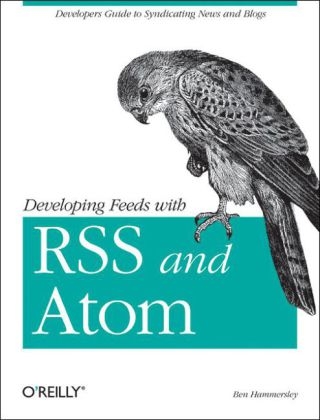
Developing Feeds with RSS and Atom
O'Reilly Media (Verlag)
978-0-596-00881-9 (ISBN)
- Lieferbar
- Versandkostenfrei
- Auch auf Rechnung
- Artikel merken
Perhaps the most explosive technological trend over the past two years has been blogging. As a matter of fact, it's been reported that the number of blogs during that time has grown from 100,000 to 4.8 million-with no end to this growth in sight. What's the technology that makes blogging tick? The answer is RSS - a format that allows bloggers to offer XML-based feeds of their content. It's also the same technology that's incorporated into the websites of media outlets so they can offer material (headlines, links, articles, etc.) syndicated by other sites. As the main technology behind this rapidly growing field of content syndication, RSS is constantly evolving to keep pace with worldwide demand. That's where Developing Feeds with RSS and Atom, 2nd Edition steps in. It provides bloggers, web developers, and programmers with a thorough explanation of syndication in general and the most popular technologies used to develop feeds. This book not only highlights all the new features of RSS 2.0-the most recent RSS specification-but also offers complete coverage of its close second in the XML-feed arena, Atom.
The book has been exhaustively revised to explain: - metadata interpretation - the different forms of content syndication - the increasing use of web services - how to use popular RSS news aggregators on the market After an introduction that examines Internet content syndication in general (its purpose, limitations, and traditions), this step-by-step guide tackles various RSS and Atom vocabularies, as well as techniques for applying syndication to problems beyond news feeds. Most importantly, it gives you a firm handle on how to create your own feeds, and consume or combine other feeds. If you're interested in producing your own content feed, Developing Feeds with RSS and Atom is the one book you'll want in hand.
Ben Hammersley is an English emigre, living in Florence, Italy, with his wife, three greyhounds, and the Renaissance. Galileo's little finger is in a jar only 400 yards from his desk. For a day job, he writes for the British national press, appearing in The Times, The Guardian and The Observer, but in his free time, he blogs excessively at www benhammersley.com. As the author of Content Syndication with RSS, he survived the Great Fork Summer, and as a journalist he has been accosted by the secret police of two countries. To this day, he doesn't know which was worse.
Preface; 1. Introduction; What Are RSS and Atom for?; A Short History of RSS and Atom; Why Syndicate Your Content?; Legal Implications; 2. Using Feeds; Web-Based Applications; Desktop Applications; Other Cunning Techniques; Finding Feeds to Read; 3. Feeds Without Programming; From Email; From a Search Engine; From Online Stores; 4. RSS 2.0; Bringing Things Up to Date; The Basic Structure; Producing RSS 2.0 with Blogging Tools; ; Introducing Modules; Creating RSS 2.0 Feeds; 5. RSS 1.0; Metadata in RSS 2.0; Resource Description Framework; RDF in XML; Introducing RSS 1.0; The Specification in Detail; Creating RSS 1.0 Feeds; 6. RSS 1.0 Modules; Module Status; Support for Modules in Common Applications; Other RSS 1.0 Modules; 7. The Atom Syndication Format; Introducing Atom; The Atom Entry Document in Detail; Producing Atom Feeds; 8. Parsing and Using Feeds; Important Issues; JavaScript Display Parsers; Parsing for Programming; Using Regular Expressions; Using XSLT; Client-Side Inclusion; Server-Side Inclusion; 9. Feeds in the Wild; Once You Have Created Your Simple RSS Feed; Publish and Subscribe; Rolling Your Own: LinkPimp PubSub; LinkpimpClient.pl; 10. Unconventional Feeds; Apache Logfiles; Code TODOs to RSS; Daily Doonesbury; Amazon.com Wishlist to RSS; FedEx Parcel Tracker; Google to RSS with SOAP; Last-Modified Files; Installed Perl Modules; The W3C Validator to RSS; Game Statistics to Excel; Feeds by SMS; Podcasting Weather Forecasts; Having Amazon Produce Its Own RSS Feeds; Cross-Poster for Movable Type; 11. Developing New Modules; Namespaces and Modules Within RSS 2.0 and Atom; Case Study: mod_Book; Extending Your Desktop Reader; Introducing AmphetaDesk; A. The XML You Need for RSS; B. Useful Sites and Software; Index
| Erscheint lt. Verlag | 17.5.2005 |
|---|---|
| Zusatzinfo | Illustrations |
| Verlagsort | Sebastopol |
| Sprache | englisch |
| Maße | 178 x 232 mm |
| Einbandart | kartoniert |
| Themenwelt | Informatik ► Web / Internet ► Web Design / Usability |
| ISBN-10 | 0-596-00881-3 / 0596008813 |
| ISBN-13 | 978-0-596-00881-9 / 9780596008819 |
| Zustand | Neuware |
| Haben Sie eine Frage zum Produkt? |
aus dem Bereich


